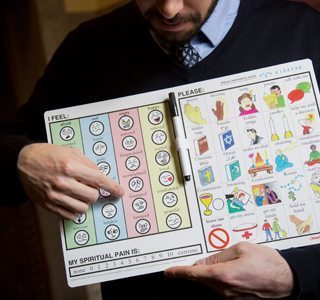Inside NYP: Joel Berning
NewYork-Presbyterian’s chaplain discusses his innovative approach to spiritual care.

When I was a kid I wanted to be a firefighter to help people in crisis. But I also wondered about spiritual things, like where do we come from and where are we going? Later on, I went to divinity school, where I heard about becoming a hospital chaplain. That appealed to me because you get to be around people from different backgrounds and faiths, and you’re there to help patients and their families when they’re struggling.
Right before I started my residency at NewYork-Presbyterian, I had a close friend who was in a bad bicycle-versus-motor vehicle accident. He ended up in the hospital. I was with him and his family, and there were times when he was awake and couldn’t talk, and I remember how distressing that was for everybody.
I knew when I started my residency at NewYork-Presbyterian that I wanted to be in a similar setting — where I could help people cope with that experience. Or, even if they couldn’t cope with it, just to be with them so they didn’t have to be alone if they didn’t want to be.
When I first started working here, I was assigned to the medical ICU, and part of my ministry was to go door to door to visit each patient. A lot of the patients were awake and alert, but they had a tube in their mouth or in their neck and they couldn’t talk. That was frustrating because I had learned how to provide spiritual care through conversation, and I wasn’t sure how to do that with these people who couldn’t talk. When I saw the large number of people critically ill, on a ventilator, and unable to speak for themselves, I wanted to figure out how to provide spiritual support to them.

Berning’s spiritual communication board
Through reading nursing and critical-care journal articles, I realized how other disciplines use communication boards illustrated with personal needs, like “I’m nauseated” or “turn me,” allowing people who can’t vocally communicate to point to what they need (or guide someone else who can point). I took that concept and made a communication board for spiritual needs. One area of the board has images that patients can point to about how they feel, and another shows images of things they might need.
This allows patients to indicate that they’re scared or lonely or that they need prayers or their hand held. We made sure that the images of needs were inclusive of everyone, including those who are religious, not religious, spiritual, agnostic, or atheist. All of the illustrations were done by another one of our chaplains, Seigan Ed Glassing, a Buddhist monk who trained at Pratt Institute in commercial art.
The idea of an integrated healthcare chaplain is a relatively new thing. Generations ago, clergies were from the outside world and they would visit their own in the hospital. Today, we’re hospital chaplains on the unit, visiting everyone. So it makes sense that you need to have some way of providing good spiritual care for patients who can’t talk. And that’s what happened.
Joel Berning, a chaplain at NewYork-Presbyterian, has invented a spiritual communication board to help ICU patients express their emotional and spiritual needs during their care. Berning conducted a study – the first of its kind – that evaluated this form of chaplain care with mechanically ventilated ICU patients.
